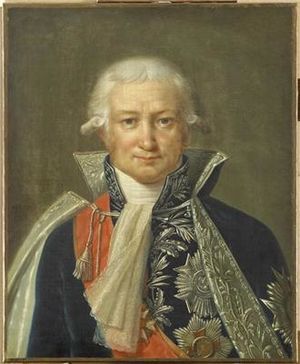Jean-Baptiste de Nompère de Champagny facts for kids
Jean-Baptiste de Nompère de Champagny, 1st Duc de Cadore (August 4, 1756 – July 3, 1834) was an important French admiral and politician.
He was born in Roanne, a town in Loire, France. In 1774, he joined the French royal navy. He fought in the war in America. After the war, he left the navy in 1787.
In 1789, he was chosen as a representative, called a député. He represented the nobles of Forez at the Estates-General. This was a big meeting in France. On June 21, he joined the Third Estate. This group represented ordinary people. He helped the National Constituent Assembly. He worked especially on making the navy better.
Contents
Jean-Baptiste de Champagny's Career
Jean-Baptiste de Champagny did not seem very interested in a political career at first. He lived a private life from 1791 to 1799. Then, Napoleon asked him to join the council of state.
Ambassador and Minister
From July 1801 to August 1804, he was France's ambassador in Vienna. He was very smart in handling talks between France and Austria. In August 1804, Napoleon made him the minister of the interior. This was a very important job. He held this position for three years. During this time, he proved to be an excellent leader.
Besides his usual duties, he also had to find new soldiers for the army. He helped organize a big exhibition in 1806. This event showed off French products. He also oversaw many public works projects. These projects included building new things in Paris and all over France.
Working for Napoleon
Champagny was very loyal to Napoleon. He often praised Napoleon in his speeches. In August 1807, Napoleon chose him to be the minister for foreign affairs. He took over from Talleyrand.
In this role, he managed important events. He oversaw the takeover of the Papal States in April 1808. He also worked to make Charles IV of Spain give up his throne in May 1808. Champagny also helped negotiate the Peace of Vienna in 1809. He even helped arrange Napoleon's marriage.
Napoleon rewarded him for his loyalty. He gave Champagny a special hereditary title. This was the title of a duché grand-fief, or Duke of Cadore. This land was in Friuli, which was part of Napoleon's kingdom in Italy. The title ended in 1893.
Later Life and Retirement
In April 1811, Champagny had a disagreement with Napoleon. This led to his retirement from his main job. He then got an easy job as the general manager of the crown's property. In 1814, after Napoleon gave up his power, the Empress sent Champagny on a mission. He tried to talk to the Emperor of Austria, but it did not work. After this, he joined the Bourbon royal family.
However, during the Hundred Days, when Napoleon returned to power, Champagny joined him again. Because of this, Louis XVIII did not allow him to hold a position. But in 1819, he got back his title as a Peer of France. He died in Paris in 1834.
Champagny's Family
Jean-Baptiste de Champagny married Victoire Blandine Hue de Grosbois on January 22, 1787. She was also born in Roanne. They had at least four sons who became famous:
- Louis Alix, 2nd Duke of Cadore (1796–1870): He was the second Duke of Cadore. He married Caroline Elisabeth de Lagrange in Paris in 1824.
- François (1804–1882): He was a well-known writer. He became a member of the French Academy in 1869. His most famous work was a history of the Roman empire. It was published in three parts.
- Napoleon (1806–1872): He wrote a four-volume book about city police rules. He also served as a representative in the Corps Législatif from 1852 to 1870.
- Jerome Paul (1809–1886): He was also a representative in the Corps Législatif from 1853 to 1870. He became an honorary chamberlain in 1859. He helped publish Napoleon I's official letters.
See also
 In Spanish: Jean-Baptiste Nompère de Champagny para niños
In Spanish: Jean-Baptiste Nompère de Champagny para niños


